
Wine Culture and Information since 2002 - Volume 22
 Wine Culture and Information since 2002 - Volume 22 |
|
Issue 231, September 2023 |
Contents |
|
|
Will There Be No Wine in the Future of Young People? |
|
There were times when wine seemed to know no obstacles, undisputed emperor of thoughts and glasses of countless consumers and enthusiasts, regardless of age – the one considered as legal, of course – gender, social background and economic condition. Wine was the preferred subject of most of the people, in particular at the table, as well as in “private occasions” and in public gatherings. Very often we ended up having endless dissertations on the wine which we had at that moment in the glass, often dreaming of having another totally different one, however necessarily being happy with the bottle which was on the table. And most of the time, more than one. This didn't just happen on “private” occasions, but also when you were in company at a table in a restaurant or wine bar. It was something concerning everyone, including young people, obviously of the age allowing the legal consumption of alcoholic beverages. It was done in moderation – at least as far as I was concerned – because, in wine, we did not see just a drink to be “simply drunk”, but the expression of a culture and knowledge that was considered seriously and with respect, a shared beverage and meant to be shared. Times have obviously passed by, wine has changed, we have changed, of course factors, conditions and the relationship of people with wine have changed as well. Including young people. For many years we have continued to talk about the relationship of the new generations with wine and – apparently – this relationship punctually and cyclically experiences moments of ups and downs. The future, in this sense, would seem to see the relationship of young people with wine even further distant. A condition that, apparently, already started a few years ago, and it doesn't seem, at the moment, that there could be a sudden new love at first sight or renewed passion. The young generation and, apparently, also the future ones, seem to be more interested in the consumption of other alcoholic beverages, especially beer which seems to have established a solid bond with them. Of course, compared to past times, beer has benefited from a development, also qualitative, decidedly unimaginable twenty years ago, at least for mass-market beers. This is also thanks to – but not limited to – the excellent job done by the countless so-called “artisan” breweries, which in recent years have flourished and grown almost everywhere in the world. Many of them have undeniably been capable of creating beers of high quality and which have joined the production – present for decades, albeit “niche” – of the historic breweries, in particular those of Northern Europe. Because, it must be said, good and huge quality beer has always existed, despite having been, so to speak, drowned by the ocean of mass production. Something happened, in many respects, also in the wine and food industry in general. After all, it is a simple law of the market: the greater the offer of products, economic potential and profit, the greater the competition. Last but not least, this also happens in any other sector. The number of wineries existing today – in quantity – is unimaginable if we compare it to that of twenty years ago. And each of them makes wine with the same goal: to sell and make a profit at the expense of all the others. Mors tua vita mea. (Your death, my life) As for the fact, then, that young people consume less wine, suggesting they are in favor of a “healthier lifestyle”, therefore reducing alcohol consumption, it should be noted that, in reality, this is not the case at all, although this may have pleased someone. Young people consume alcohol, and sometimes even in “worrying” quantities, especially in the form of beer and spirits. Admittedly, alcohol is alcohol anyway, regardless of its origin or production: it makes no difference whether it is contained in wine or in any other beverage. After all, it is the sum that makes the total. The sum, indeed. Because if it is true that beer is – and will probably be in the future – the alcoholic beverage most consumed by young people, it must also be said that its consumption does not stop at just one glass, rather several bottles. Considering, not least, the economic factor, as four bottles of “mass-market” beer cost, on average, much less than one bottle of “modest” wine, however the quantity of alcohol consumed is greater. If current estimates see young people consume less wine – preferring other alcoholic beverages – the trend for the future could be even more negative, towards a progressive and inexorable lack of interest. On the occasion of the last general assembly of the Unione Italiana Vini (UIV, Italian Wine Union), it was underlined that in the immediate future the trend in the demand for wine will progressively decrease. The cause would be to be found in the progressive increase in the average age and the lack of interest for wine in new generations. The immediate forecast is for an increase in the consumption rate of just 7%, with an estimated average annual growth of 0.35%, a forecast which is believed to be valid until 2039. According to the Observatory of Unione Italiana Vini, in the future, exports will progressively represent the fundamental discriminating factor of the market, forecasting an estimated decrease in domestic consumption of -1.2 million hectoliters. The study conducted by UIV analyzed the trends relating to the progressive aging of consumers. If in the decade 1990/1999 the consumption of the over 65 population and the under 25 population was in perfect parity – about 18% – a drastic decrease is forecast for the decade ending in 2039. At that time, in fact, it is expected to see the population over 65 representing 30% of consumption, while the population under 25 will drop to 13%. The same forecast should also take place in the other main European wine producing countries – Italy, France, Spain and Germany – thus confirming the current and progressive downward trend. Habits and consumption have changed in all these countries since the 1960s, when the Italians and French registered a per capita consumption of 140 litres. Regardless of these estimates and figures, the progressive disinterest of young people in wine is something that has been noticed since many years now. And it should be emphasized that it is not a matter of their lack of interest in alcohol intake, given that young people willingly consume other alcoholic beverages, especially beer and spirits. Personally – from what I see, read and hear – it is the result derived from the way wine has been treated and considered in the last ten years, more or less. In this period, in fact, we witnessed the rise of “mediocre wine storytellers”, who, not possessing any wine culture and expertise, started a trivial and superficial writing style, arguing, no less, the communication of wine had to be “simplified”, made easy (and you know, in Italy when you use English everything becomes more “easy”, indeed ”eezee”, like the Italians pronounce it) just to make wine appealing to young people and promoting its consumption. The strategy – of which producers must be considered accomplices and guilty because have easily fallen under the spell of the easy communication revolution – has produced a detachment of interest from young people towards wine. To me, this is the obvious consequence. Simplification is nothing more than the trivialization of a concept, stripping it of everything and in the end nothing remains, just a trivial easy drink like any other easy drink. Wine has been trivialized to the level of cheeky and easy-to-drink beverage: just uncork and drink, just like what you would do with any non-alcoholic drink or soda pop, then be happy, carefree and easy. Furthermore, by considering no one is “foolish” – especially young people – when a consumer decides to have an easy drink look at what he or she has in the pockets and then make a decision. Why, unless he or she has a genuine interest, should the young consumer choose an easy wine when with a tenth of its price, and even less, can be bought an equally easy drink? Not to mention, even more than one? If wine is degraded to the level of a carefree and careless beverage, like any other drink – not to mention, a deplorable attitude, given that wine is an alcoholic beverage – one cannot therefore complain the wine has been ignored for the fact it is more expensive. Not to mention, those who, in adopting this type of commercial and promotional policy, never fail to emphasize that wine, even in the shiny and bewitching young and easy version, is culture, tradition, quality and all the well-known fairy tales that often follow. It doesn't work and the young people are proving it to you. Why should they prefer wine, in the fascinating guise of easy drink, anonymous and ordinary wines, when the competition in that market is capable of offering winning alternatives at a decidedly lower price and, above all, just as “easy”, indeed, undeniably much easier? Antonello Biancalana
|
||||
Contrasts of Alto Adige Müller Thurgau and Cirò BiancoA comparison between distant and opposite geographical and enological conditions, two wines and grapes with different histories and characters, children of the mountains and the sea, of cool temperatures and warm sea breezes. |
|
Two stories so distant that it would seem impossible to compare them. On the one side we have a grape which is the result of research and commitment, the fruit of a decidedly successful crossing and which has conquered vineyards in almost all the wine-growing countries of the world, not least, the glasses of enthusiasts. On the other side, a variety of Greek origin which found a magnificent environment in Calabria, so much so that today it is considered autochthonous and used in most of the white wines of the region. This month we are comparing in our glasses two grapes of great personality and capable of making excellent wines in their respective denominations and territories. Our tasting by contrast will focus on the analysis of Alto Adige Müller Thurgau – produced with the famous crossing and today found in many wine-growing countries of the world – and Cirò Bianco, one of the many remarkable enological excellence of Calabria and produced with Greco Bianco grape. These are two wines and territories that are very distant from each other and not only for geographical reasons. The finesse and crispness of the wines of Alto Adige, result – last but not least – of its environmental and climatic conditions, is fundamental for varieties with marked aromatic qualities, very common and used in the region. Among these, we certainly have Müller Thurgau which in Alto Adige makes wines capable of developing the pleasing aromatic expression of the grape and crispness, without ever exceeding with structures which would give the wine a fuller body at the expense of elegance. Not least, Calabria is also characterized by white wines of finesse and crispness, however, because of the different climatic and environmental conditions – not least, the varieties typically found in this region – have a greater structure. The star variety of Cirò Bianco – one of the most famous denominations in Calabria, especially for the reds – is Greco Bianco, a grape of Greek origins and today considered indigenous to Calabria, not to be confused with the Greco grape, the famous white berried variety from Campania.
|
|
Alto Adige is an extraordinary land of white and red wines, often characterized by elegant finesse and crispness. In this Italian region – close to the Alps – all those varieties which benefit from a cool climate for the development of their aromatic qualities and crispness, find magnificent expression. Among the white berried varieties which in Alto Adige are successful in fully expressing their character of finesse – both in the aromas and taste – we unquestionably find Müller Thurgau. The history of this grape is fascinating and amazing, the result of the commitment of its creator – it is in fact a crossbreed – including the confusion about its real origin and which only at the beginning of the 2000s was possible to definitively clarify thanks to specific genetic research on its DNA. This very interesting variety is the result of research by Prof. Hermann Müller towards the end of the 1800s – who at the time worked at the Geisenheim Grape Breeding Institute, Germany – and intended to create a variety of vine capable of combining the finesse and intensity of the Rhine Riesling with the capability of early ripening of the Sylvaner. The grape he obtained did not possess the qualities he wanted to create, however it turned out to have interesting enological potential, so as to become very popular in Germany. For the new grape, its creator chose the name of Müller Thurgau, thus combining his surname with that of Thurgau (Thurgovia), the Swiss canton in which he was born in 1850. Although Prof. Hermann Müller was convinced that he had used the Sylvaner, many doubted, putting forward the hypothesis that, in reality, the variety crossed with Rhine Riesling was actually another one. We will have to wait for the 2000s when the origin of this variety was finally and definitively clarified, thanks to research conducted on its DNA. It was therefore found out that Müller Thurgau is actually a cross between Rhine Riesling and Madeleine Royale. Specifically, it was discovered that it was this variety to be used to pollinate Rhine Riesling. Müller Thurgau, since the time of its creation, has enjoyed enormous success and, besides Germany – where it is quite common – it is also present in many wine-growing countries of the world. Müller Thurgau is also found in Italy, especially in Alto Adige.
|
||||
|
Calabria is a beautiful land of wine, and it is here that the Greek enological influence began, first in the area called Magna Graecia and then spread throughout most of Italy. The enological production of this region is mainly known for its red wines – in particular, for those produced with Gaglioppo, Magliocco, Nerello Cappuccio and Greco Nero grapes - however there are worthy representatives also in white wines. In this sense, the absolute protagonist of Calabria undeniably is Greco Bianco, a variety which, despite having clear Greek origins, is now considered to be indigenous of the region. In this regard, it should be noted that Greco Bianco cultivated in Calabria is a variety which has no genetic link with Greco, the famous white berried variety mainly found in Campania and known for the production of Greco di Tufo. The name of this Calabrian variety should in fact be better defined as Greco Bianco di Bianco or Greco di Bianco. The reference is not about the color (bianco is Italian for “white”) but to the town of the same name in the province of Reggio Calabria, where the precious sweet wine from dried grapes Greco di Bianco DOC is produced. This interesting variety is among the oldest in Italy, and it is believed it was introduced by Greek colonists around the 7th century BC, when they landed in the area of the promontory of Zefirio, near the town of Bianco. The variety is now widely spread and cultivated in Calabria and – in fact – it is the main white berried variety in the region, present in various Denominazione d'Origine Controllata (Denomination of Controlled Origin, DOC) and, among these, Cirò. This important denomination of Calabria, certainly among the best known, mainly owes its fame to red wines, notoriously produced with Gaglioppo grape. The disciplinary also provides for the production of white wines, which are mainly produced with Greco Bianco grape. Despite other varieties are allowed, most of the white wines belonging to the Cirò denomination are produced with 100% Greco Bianco.
|
The two wines we will pour into our glasses for this month's tasting are pretty easy to find. In fact, these are bottles produced in wine-growing territories that enjoy good popularity, in particular Alto Adige Müller Thurgau. Among the enological representatives of the Cirò appellation, as already mentioned, the most known and widespread ones are red wines, however also the other two styles of the denomination – white and rosé – catch the interest of wine lovers. As already mentioned in the past, in choosing our wines we need to make sure the bottles are produced with the respective grapes alone. In fact, it should be noticed that Alto Adige DOC production disciplinary allows the minimum use of 85% of the variety indicated on the label, with any remaining part made up of varieties allowed in the region. The same consideration is valid for Cirò Bianco as the relative disciplinary provides for the minimum use of Greco Bianco for 80%. For both wines we will make sure that they have been vinified in steel tanks and belonging to the most recent vintage. Alto Adige Müller Thurgau and Cirò Bianco are poured into tasting glasses at a temperature of 10 °C. (50 °F) We can now start our tasting by contrast and pour Alto Adige Müller Thurgau and Cirò Bianco into their respective tasting glasses. The first wine we will examine is the one from Alto Adige, therefore proceeding with the first phase of the evaluation, that is how the wine appears to our eyes. Let's hold the glass tilted over a white surface – a sheet of paper is enough – and observe the base, where the thickness of the wine is more consistent. Alto Adige Müller Thurgau shows a brilliant greenish yellow color, sometimes with straw yellow hues, and a very high transparency. Let's now pay attention to the opening of the glass, where the thickness of the wine becomes thin, and let's evaluate its nuances. The color that is detected is still bright greenish yellow. Let's now pass to the evaluation of the appearance of Cirò Bianco, also in this case by holding the glass tilted over the white surface. The color of the Calabrian wine – observed at the base – reveals brilliant and intense straw yellow, whereas the nuances, observed towards the opening of the glass, reveal greenish yellow. The olfactory profiles of Alto Adige Müller Thurgau and Cirò Bianco are very different from each other and the nose reveals significant differences. This is of course because of the varieties used for their production – respectively, Müller Thurgau and Greco Bianco – as well as the environmental and climatic conditions of Alto Adige and Calabria. In the first case it is high-altitude environment with cool and moderate temperatures, in the other case the climate is decidedly hotter and is influenced by the breezes from the Ionian Sea. The aromas of Müller Thurgau, especially when cultivated in cool areas such as Alto Adige, mainly recall white and yellow pulp fruit, as well as exotic ones, such as peach, apple, pineapple, pear, banana and apricot. As far as perfumes attributable to the world of flowers are concerned, Müller Thurgau mainly expresses broom, hawthorn, acacia and, sometimes, elder flower. The olfactory profile of Greco Bianco – therefore of Cirò Bianco – is characterized by fruit sensations in which we recognize apple, including green apple, pear, pineapple and peach, as well as a pleasing hint of almond. The flower world of Greco Bianco is mainly represented by hawthorn and broom. Let's continue our tasting by contrast and proceed with the evaluation of the olfactory profiles of Alto Adige Müller Thurgau and Cirò Bianco, starting – as in the previous examination – from the Alto Adige wine. Let's hold the glass in vertical position and, without swirling, proceed with the first smell in order to perceive the opening of the wine, that is the primary and identifying olfactory sensations. From the glass are perceived intense and refined aromas of peach, pineapple and apple as well as floral sensations of acacia and broom. Let's now proceed with the swirling of the glass in order to favor the development of the remaining aromas which will complete the profile of the wine. Alto Adige Müller Thurgau now expresses aromas of pear, banana, apricot, lychee and gooseberry, as well as the scent of chamomile and, sometimes, elder flower. Furthermore, in this wine can be perceived sensations reminiscent of aromatic and vegetable herbs, such as sage, thyme and nettle. Let's now pass to the evaluation of the opening of Cirò Bianco, therefore – by holding the glass in vertical position – let's evaluate its opening. The wine produced with Greco Bianco opens with intense and refined aromas of apple, pear and peach, as well as the floral sensation of hawthorn. After having swirled the glass, the profile of Cirò Bianco is completed with pineapple, plum and broom, sometimes followed by the pleasing scent of almond. Let's move on to the evaluation of the gustatory profiles of the two wines, starting, as in the previous phases, from Alto Adige Müller Thurgau. Let's therefore take a sip of this wine in order to evaluate its attack, that is the primary and identifying sensations. The South Tyrolean wine is appreciated in the mouth for its pleasing crispness given by acidity, with a moderate contribution of alcohol but clearly enough to reach balance. The structure of this wine is medium, with finesse and very pleasing elegance on the mouth which is also expressed by the flavors of peach, pineapple and apple, therefore a good correspondence to the nose. The gustatory profile of Cirò Bianco is quite different and, after the first sip, it reveals a fuller structure than Alto Adige Müller Thurgau, however expressing an evident crisp attack which promptly finds the balance thanks to the contribution of alcohol, usually of greater intensity than the South Tyrolean wine. In the mouth, moreover, we clearly perceive flavors of apple, pear and peach, also in this case, a good correspondence to the nose. We have reached the end of this month's tasting by contrast, therefore let's proceed with the evaluation of the final sensations Alto Adige Müller Thurgau and Cirò Bianco leave in the mouth after swallowing. Among the most important aspects which are evaluated in this last phase, there is the taste-olfactory persistence, notoriously one of the primary factors defining the quality of a wine. The finish of Alto Adige Müller Thurgau is persistent, leaving in the mouth its pleasing sensation of crispness and moderate body, as well as the intense flavors of peach, pineapple and apple. Also the finish of Cirò Bianco is persistent and – compared to the previous wine – will be perceived a sensation of fuller structure as well as the pleasing crispness given by acidity. In the mouth are also perceived flavors of apple, pear, peach and plum, often accompanied by a pleasing bitter sensation in which we recognize almond. Alto Adige Müller Thurgau and Cirò Bianco are pretty different and distant wines, in both cases expression of finesse and elegance, as well as excellent representatives of their respective regions.
|
||||||||
Wines of the Month |
|
|
|
Score legend Prices are to be considered as indicative. Prices may vary according to the country or the shop where wines are bought |
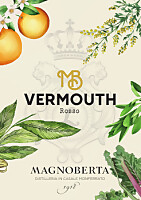
|
|
Vermouth Rosso MB |
|
| Magnoberta (Piedmont, Italy) | |
 n.d. n.d. | |
| Price: € 18.00 | Score: |
 Intense amber yellow and nuances of amber yellow, moderate
transparency. Intense amber yellow and nuances of amber yellow, moderate
transparency.
 Intense, clean, pleasing and refined, starts with hints of artemisia,
gentian, cinchona and nutmeg followed by aromas of chamomile, citrus fruit
peel, ginger, coriander, cinnamon, sage and cardamom. Intense, clean, pleasing and refined, starts with hints of artemisia,
gentian, cinchona and nutmeg followed by aromas of chamomile, citrus fruit
peel, ginger, coriander, cinnamon, sage and cardamom.
 Sweet and round attack, however balanced by alcohol, good body, intense
flavors, pleasing crispness. Sweet and round attack, however balanced by alcohol, good body, intense
flavors, pleasing crispness.
 Persistent finish with flavors of artemisia, cinchona and gentian. Persistent finish with flavors of artemisia, cinchona and gentian. Wine aromatized with essences. Wine aromatized with essences. |
|
 Aperitifs, Dried fruits, Jam tarts, Hard cheese Aperitifs, Dried fruits, Jam tarts, Hard cheese |
|

|
|
Valle d'Aosta Bianco Ensemblo 2018 |
|
| La Source (Vallée d'Aoste, Italy) | |
 Traminer (50%), Moscato Bianco (40%), Müller Thurgau (10%) Traminer (50%), Moscato Bianco (40%), Müller Thurgau (10%) | |
| Price: € 15.00 | Score: |
 Deep golden yellow and nuances of golden yellow, transparent. Deep golden yellow and nuances of golden yellow, transparent. Intense, clean, pleasing and refined, starts with hints of grape, peach
and banana followed by aromas of white rose, hawthorn, broom, apple, pear
and plum. Intense, clean, pleasing and refined, starts with hints of grape, peach
and banana followed by aromas of white rose, hawthorn, broom, apple, pear
and plum.
 Crisp attack and however balanced by alcohol, good body, intense
flavors, pleasing roundness. Crisp attack and however balanced by alcohol, good body, intense
flavors, pleasing roundness.
 Persistent finish with flavors of grape, peach and banana. Persistent finish with flavors of grape, peach and banana. Aged in steel tanks. Aged in steel tanks. |
|
 Pasta and risotto with crustaceans, Broiled crustaceans, Stewed fish, Dairy products, Mushroom soups Pasta and risotto with crustaceans, Broiled crustaceans, Stewed fish, Dairy products, Mushroom soups |
|

|
|
Valle d'Aosta Torrette Superiore 2017 |
|
| La Source (Vallée d'Aoste, Italy) | |
 Petit Rouge (90%), Fumin (10%) Petit Rouge (90%), Fumin (10%) | |
| Price: € 20.00 | Score: |
 Intense ruby red and nuances of garnet red, little transparency. Intense ruby red and nuances of garnet red, little transparency. Intense, clean, pleasing, refined and elegant, starts with hints of
black cherry, plum and rose followed by aromas of raspberry, strawberry,
blueberry, chocolate, tobacco, carob, vanilla and menthol. Intense, clean, pleasing, refined and elegant, starts with hints of
black cherry, plum and rose followed by aromas of raspberry, strawberry,
blueberry, chocolate, tobacco, carob, vanilla and menthol.
 Properly tannic attack and however balanced by alcohol, good body,
intense flavors, pleasing roundness. Properly tannic attack and however balanced by alcohol, good body,
intense flavors, pleasing roundness.
 Persistent finish with flavors of black cherry, plum and raspberry. Persistent finish with flavors of black cherry, plum and raspberry. 8 months in cask. 8 months in cask. |
|
 Stuffed pasta with meat, Broiled meat and barbecue, Stewed meat with mushrooms Stuffed pasta with meat, Broiled meat and barbecue, Stewed meat with mushrooms |
|

|
|
Lugana Argillaia 2022 |
|
| Fabiano (Veneto, Italy) | |
 Turbiana Turbiana | |
| Price: € 16.00 | Score: |
 Brilliant straw yellow and nuances of greenish yellow, very
transparent. Brilliant straw yellow and nuances of greenish yellow, very
transparent.
 Intense, clean, pleasing and refined, starts with hints of apple, plum
and hawthorn followed by aromas of broom, citron, pear, pineapple, peach,
tangerine and almond. Intense, clean, pleasing and refined, starts with hints of apple, plum
and hawthorn followed by aromas of broom, citron, pear, pineapple, peach,
tangerine and almond.
 Crisp attack and however balanced by alcohol, good body, intense
flavors, agreeable. Crisp attack and however balanced by alcohol, good body, intense
flavors, agreeable.
 Persistent finish with flavors of apple, plum and citron. Persistent finish with flavors of apple, plum and citron. 5 months in steel tanks, 1 month in bottle. 5 months in steel tanks, 1 month in bottle. |
|
 Pasta and risotto with fish and crustaceans, Sauteed fish, Sauteed white meat, Vegetable flans, Dairy products, Eggs Pasta and risotto with fish and crustaceans, Sauteed fish, Sauteed white meat, Vegetable flans, Dairy products, Eggs |
|
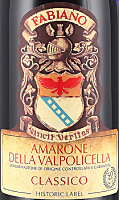
|
|
Amarone della Valpolicella Classico 2018 |
|
| Fabiano (Veneto, Italy) | |
 Corvina (40%), Corvinone (30%), Rondinella (25%), Croatina (5%) Corvina (40%), Corvinone (30%), Rondinella (25%), Croatina (5%) | |
| Price: € 48.00 | Score: |
 Brilliant ruby red and nuances of garnet red, little transparency. Brilliant ruby red and nuances of garnet red, little transparency. Intense, clean, pleasing, refined and elegant, starts with hints of
plum, black cherry and blackberry followed by aromas of dried violet,
blueberry, raspberry, chocolate, tobacco, cinnamon, mace, vanilla and
menthol. Intense, clean, pleasing, refined and elegant, starts with hints of
plum, black cherry and blackberry followed by aromas of dried violet,
blueberry, raspberry, chocolate, tobacco, cinnamon, mace, vanilla and
menthol.
 Properly tannic attack and however balanced by alcohol, full body,
intense flavors, pleasing roundness. Properly tannic attack and however balanced by alcohol, full body,
intense flavors, pleasing roundness.
 Persistent finish with flavors of plum, black cherry and blackberry. Persistent finish with flavors of plum, black cherry and blackberry. 30 months in cask, 3 months in bottle. 30 months in cask, 3 months in bottle. |
|
 Game, Roasted meat, Braised and stewed meat, Hard cheese Game, Roasted meat, Braised and stewed meat, Hard cheese |
|
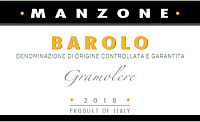
|
|
Barolo Gramolere 2018 |
|
| Manzone Giovanni (Piedmont, Italy) | |
 Nebbiolo Nebbiolo | |
| Price: € 45.00 | Score: |
 Brilliant ruby red and nuances of garnet red, moderate transparency. Brilliant ruby red and nuances of garnet red, moderate transparency. Intense, clean, pleasing, refined and elegant, starts with hints of
cherry, plum and violet followed by aromas of rose, raspberry, strawberry,
cinnamon, tobacco, chocolate, pink pepper, licorice, leather, vanilla and
menthol. Intense, clean, pleasing, refined and elegant, starts with hints of
cherry, plum and violet followed by aromas of rose, raspberry, strawberry,
cinnamon, tobacco, chocolate, pink pepper, licorice, leather, vanilla and
menthol.
 Tannic attack and however balanced by alcohol, full body, intense
flavors, pleasing crispness. Tannic attack and however balanced by alcohol, full body, intense
flavors, pleasing crispness.
 Very persistent finish with long flavors of cherry, plum and raspberry. Very persistent finish with long flavors of cherry, plum and raspberry. 30 months in cask. 30 months in cask. |
|
 Game, Roasted meat, Stewed and braised meat, Hard cheese Game, Roasted meat, Stewed and braised meat, Hard cheese |
|
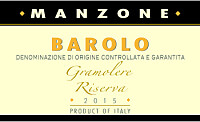
|
|
Barolo Riserva Gramolere 2015 |
|
| Manzone Giovanni (Piedmont, Italy) | |
 Nebbiolo Nebbiolo | |
| Price: € 75.00 | Score: |
 Brilliant ruby red and nuances of garnet red, moderate transparency. Brilliant ruby red and nuances of garnet red, moderate transparency. Intense, clean, pleasing, refined and elegant, starts with hints of
cherry, plum and violet followed by aromas of rose, raspberry, strawberry,
cocoa, tobacco, thyme, cinnamon, licorice, leather, face powder, mace, pink
pepper, vanilla and menthol. Intense, clean, pleasing, refined and elegant, starts with hints of
cherry, plum and violet followed by aromas of rose, raspberry, strawberry,
cocoa, tobacco, thyme, cinnamon, licorice, leather, face powder, mace, pink
pepper, vanilla and menthol.
 Tannic attack and however balanced by alcohol, full body, intense
flavors, pleasing crispness. Tannic attack and however balanced by alcohol, full body, intense
flavors, pleasing crispness.
 Very persistent finish with long flavors of cherry, plum and raspberry. Very persistent finish with long flavors of cherry, plum and raspberry. More than 50 months in cask. More than 50 months in cask. |
|
 Game, Stewed and braised meat, Roasted meat, Hard cheese Game, Stewed and braised meat, Roasted meat, Hard cheese |
|
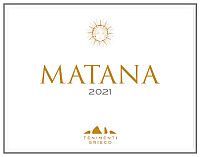
|
|
Matana 2021 |
|
| Tenimenti Grieco (Molise, Italy) | |
 Chardonnay Chardonnay | |
| Price: € 16.80 | Score: |
 Brilliant golden yellow and nuances of golden yellow, very transparent. Brilliant golden yellow and nuances of golden yellow, very transparent. Intense, clean, pleasing and refined, starts with hints of banana,
grapefruit and acacia followed by aromas of hawthorn, citron, apple, pear,
plum, praline and hints of vanilla. Intense, clean, pleasing and refined, starts with hints of banana,
grapefruit and acacia followed by aromas of hawthorn, citron, apple, pear,
plum, praline and hints of vanilla.
 Crisp attack and however balanced by alcohol, good body, intense
flavors, pleasing roundness. Crisp attack and however balanced by alcohol, good body, intense
flavors, pleasing roundness.
 Persistent finish with flavors of banana, grapefruit and apple. Persistent finish with flavors of banana, grapefruit and apple. A small part of the wine is fermented in barrique. 6 months in steel
tanks, 3 months in bottle. A small part of the wine is fermented in barrique. 6 months in steel
tanks, 3 months in bottle.
|
|
 Pasta with mushrooms and fish, Sauteed white meat, Broiled fish, Legume soups Pasta with mushrooms and fish, Sauteed white meat, Broiled fish, Legume soups |
|
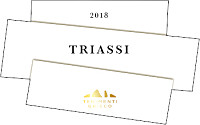
|
|
Triassi 2018 |
|
| Tenimenti Grieco (Molise, Italy) | |
 Cabernet Sauvignon (55%), Merlot (35%), Aglianico (10%) Cabernet Sauvignon (55%), Merlot (35%), Aglianico (10%) | |
| Price: € 27.00 | Score: |
 Intense ruby red and nuances of garnet red, little transparency. Intense ruby red and nuances of garnet red, little transparency. Intense, clean, pleasing, refined and elegant, starts with hints of
black cherry, black currant and blackberry followed by aromas of violet,
plum, blueberry, chocolate, tobacco, carob, licorice, leather, black
pepper, mace, vanilla and eucalyptus. Intense, clean, pleasing, refined and elegant, starts with hints of
black cherry, black currant and blackberry followed by aromas of violet,
plum, blueberry, chocolate, tobacco, carob, licorice, leather, black
pepper, mace, vanilla and eucalyptus.
 Properly tannic attack and however balanced by alcohol, full body,
intense flavors, pleasing roundness. Properly tannic attack and however balanced by alcohol, full body,
intense flavors, pleasing roundness.
 Persistent finish with flavors of black cherry, black currant and
blackberry. Persistent finish with flavors of black cherry, black currant and
blackberry.
 21 months in barrique, 6 months in bottle. 21 months in barrique, 6 months in bottle. |
|
 Game, Roasted meat, Stewed and braised meat, Hard cheese Game, Roasted meat, Stewed and braised meat, Hard cheese |
|

|
|
Gioia del Colle Primitivo Corte Sant'Elia 2019 |
|
| Armònja (Apulia, Italy) | |
 Primitivo Primitivo | |
| Price: € 17.00 | Score: |
 Deep ruby red and nuances of garnet red, little transparency. Deep ruby red and nuances of garnet red, little transparency. Intense, clean, pleasing and refined, starts with hints of prune,
blackberry and black cherry followed by aromas of dried violet, blueberry,
tamarind, carob, chocolate, tobacco, vanilla and menthol. Intense, clean, pleasing and refined, starts with hints of prune,
blackberry and black cherry followed by aromas of dried violet, blueberry,
tamarind, carob, chocolate, tobacco, vanilla and menthol.
 Properly tannic attack and however balanced by alcohol, good body,
intense flavors, pleasing roundness. Properly tannic attack and however balanced by alcohol, good body,
intense flavors, pleasing roundness.
 Persistent finish with flavors of prune, blackberry and black cherry. Persistent finish with flavors of prune, blackberry and black cherry. 6 months in steel tanks, 3 months in cask, 3 months in bottle. 6 months in steel tanks, 3 months in cask, 3 months in bottle. |
|
 Stuffed pasta with meat, Broiled meat and barbecue, Roasted meat, Stewed meat, Hard cheese Stuffed pasta with meat, Broiled meat and barbecue, Roasted meat, Stewed meat, Hard cheese |
|
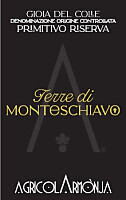
|
|
Gioia del Colle Primitivo Riserva Terre di Monteschiavo 2019 |
|
| Armònja (Apulia, Italy) | |
 Primitivo Primitivo | |
| Price: € 25.00 | Score: |
 Deep ruby red and nuances of garnet red, little transparency. Deep ruby red and nuances of garnet red, little transparency. Intense, clean, pleasing, refined and elegant, starts with hints of
black cherry, prune and dried violet followed by aromas of blackberry,
blueberry, tamarind, carob, tobacco, cocoa, leather, licorice, vanilla and
menthol. Intense, clean, pleasing, refined and elegant, starts with hints of
black cherry, prune and dried violet followed by aromas of blackberry,
blueberry, tamarind, carob, tobacco, cocoa, leather, licorice, vanilla and
menthol.
 Properly tannic attack and however balanced by alcohol, full body,
intense flavors, pleasing roundness. Properly tannic attack and however balanced by alcohol, full body,
intense flavors, pleasing roundness.
 Persistent finish with flavors of black cherry, prune and blackberry. Persistent finish with flavors of black cherry, prune and blackberry. 12 months in steel tanks, 6 months in cask, 6 months in bottle. 12 months in steel tanks, 6 months in cask, 6 months in bottle. |
|
 Game, Roasted meat, Braised and stewed meat, Hard cheese Game, Roasted meat, Braised and stewed meat, Hard cheese |
|
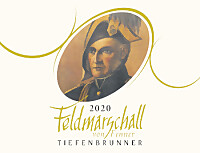
|
|
Alto Adige Müller Thurgau Feldmarschall Von Fenner 2020 |
|
| Tiefenbrunner (Alto Adige, Italy) | |
 Müller Thurgau Müller Thurgau | |
| Price: € 40.00 | Score: |
 Pale straw yellow and nuances of greenish yellow, very transparent. Pale straw yellow and nuances of greenish yellow, very transparent. Intense, clean, pleasing, refined and elegant, starts with hints of
pear, apricot and apple followed by aromas of hawthorn, wisteria,
chamomile, broom, jasmine, pineapple, peach, pear, plum, nettle, elder
flower, sage, flint and yeast. Intense, clean, pleasing, refined and elegant, starts with hints of
pear, apricot and apple followed by aromas of hawthorn, wisteria,
chamomile, broom, jasmine, pineapple, peach, pear, plum, nettle, elder
flower, sage, flint and yeast.
 Crisp attack and however balanced by alcohol, good body, intense
flavors, agreeable. Crisp attack and however balanced by alcohol, good body, intense
flavors, agreeable.
 Very persistent finish with long flavors of pear, apricot and
pineapple. Very persistent finish with long flavors of pear, apricot and
pineapple.
 Fermented in cask and cement tanks. 6 months in bottle. Fermented in cask and cement tanks. 6 months in bottle. |
|
 Pasta with fish and crustaceans, Broiled crustaceans, Sauteed fish, Sauteed white meat, Vegetable flans, Dairy products Pasta with fish and crustaceans, Broiled crustaceans, Sauteed fish, Sauteed white meat, Vegetable flans, Dairy products |
|
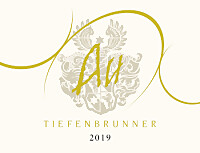
|
|
Alto Adige Chardonnay Riserva Vigna Au 2019 |
|
| Tiefenbrunner (Alto Adige, Italy) | |
 Chardonnay Chardonnay | |
| Price: € 69.00 | Score: |
 Brilliant straw yellow and nuances of straw yellow, very transparent. Brilliant straw yellow and nuances of straw yellow, very transparent. Intense, clean, pleasing, refined and elegant, starts with hints of
banana, citron and acacia followed by aromas of hawthorn, passion fruit,
pineapple, mango, grapefruit, apple, pear, plum, praline, butter, vanilla
and flint. Intense, clean, pleasing, refined and elegant, starts with hints of
banana, citron and acacia followed by aromas of hawthorn, passion fruit,
pineapple, mango, grapefruit, apple, pear, plum, praline, butter, vanilla
and flint.
 Crisp attack and however balanced by alcohol, good body, intense
flavors, pleasing roundness. Crisp attack and however balanced by alcohol, good body, intense
flavors, pleasing roundness.
 Very persistent finish with long flavors of banana, citron and passion
fruit. Very persistent finish with long flavors of banana, citron and passion
fruit.
 Fermented and aged in barrique for 12 months, 6 months in steel tanks, 12
months in bottle. Fermented and aged in barrique for 12 months, 6 months in steel tanks, 12
months in bottle.
|
|
 Pasta with fish and mushrooms, Broiled fish, Roasted white meat, Stewed fish with mushrooms Pasta with fish and mushrooms, Broiled fish, Roasted white meat, Stewed fish with mushrooms |
|
News |
|
In this section are published news and information about events concerning the world of wine and food. Whoever is interested in publishing this kind of information can send us a mail to our address.
|
AquavitaeReview of Grappa, Distillates and Brandy |
|
|
||||||||||||
Wine Guide ParadeMay 2023
|
| |||||||
Privacy Policy | |||||||


| Copyright © 2002-2024 Antonello Biancalana, DiWineTaste - All rights reserved |
| All rights reserved under international copyright conventions. No part of this publication and of this WEB site may be
reproduced or utilized in any form or by any means, electronic or mechanical, without permission in writing from DiWineTaste. |